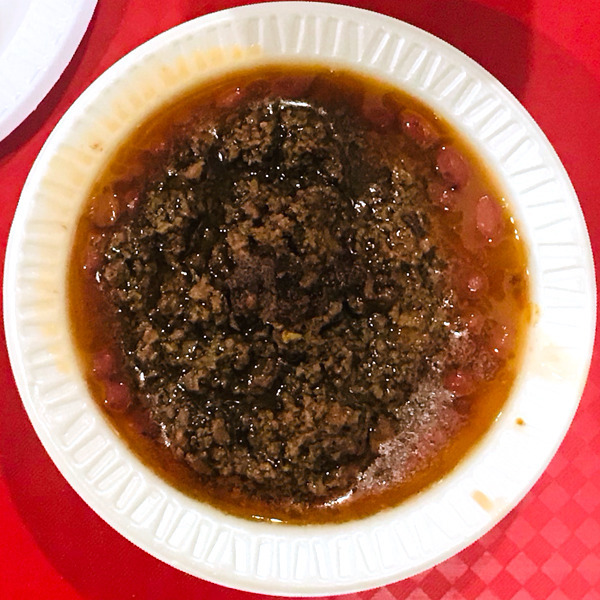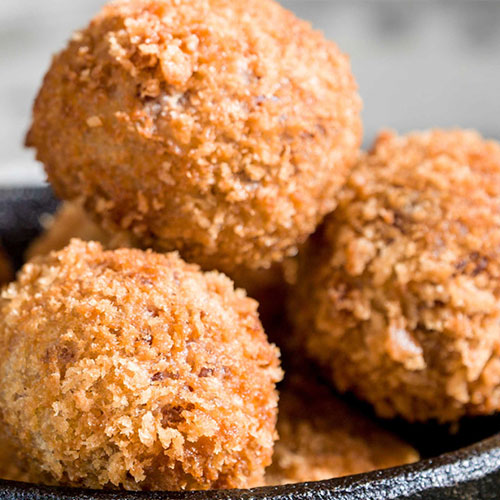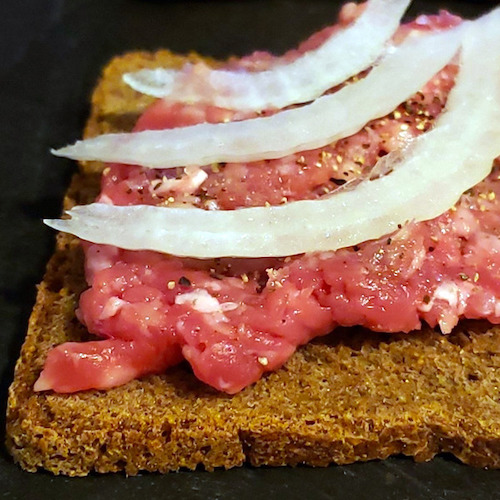It’s “unbridled plebeian opulence,” Roadfood founders Jane and Michael Stern wrote in 500 Things to Eat Before It’s Too Late. “It sits on [the stomach] like concrete,” fan Joe Whitehead told a reporter from the Wall Street Journal. “It’s like they got all the ingredients for lunch from IKEA, but they didn’t have the instructions to assemble it properly,” Peter Sagal opined on NPR’s Wait Wait Don’t Tell Me. Illinois’s most controversial sandwich is a Springfield special: the Horseshoe.
I remember the first time I heard about the Horseshoe. I was a freshman at the University of Illinois in Champaign-Urbana. My girlfriend, Julie, later my wife, was from Springfield. Steve, my neighbor in the dorm, was from the northwest side of Chicago. Steve’s father was a long-term state legislator, though, and while growing up, Steve often accompanied his father on trips to the state capital. He talked fondly about hanging out over lunch with his dad and his political buddies at Norb Andy’s Tabarin. “Norb’s has this clock that goes backward… and Springfield’s best Horseshoe.” Julie emphatically disagreed: “Springfield’s best Horseshoe came from the Red Lion Room in the old Leland Hotel.”
Horseshoe? I asked. “It’s a heart attack on a plate!” they both replied. Steve explained: Two pieces of toast topped with a thick piece of meat, then heaped with fries and smothered with cheese sauce.
That’s what it had become, anyway.
Julie remembered the Red Lion Room. It was the most exquisite restaurant in the city’s most exquisite hotel. Waitresses wore medieval costumes—long red velvet dresses with laced bodices and matching caps. They served legislators and visiting dignitaries. Julie ate there with her grandfather, staying quiet so the two could listen to the political murmurings around the dining room. And there, in 1928, chef Joe Schweska likely invented the Horseshoe.
Horseshoe? I asked. “It’s a heart attack on a plate!” they both replied. Steve explained: Two pieces of toast topped with a thick piece of meat, then heaped with fries and smothered with cheese sauce.
According to legend, as I later heard, Schweska came up with the sandwich after he ordered too much ham one Easter Sunday. His wife, Elizabeth, suggested that he serve the leftovers on an open-faced sandwich with a Welsh rarebit-inspired cheese sauce—like the sauce on Kentucky’s open-faced Hot Brown, created at Louisville’s Brown Hotel in 1926. (The Hot Brown, an iconic sandwich in its own right, could have inspired the Horseshoe, or maybe the emergence of both sandwiches around the same time just shows the tastes of American hotel guests in the ’20s.)
The original sandwich was two half-inch-thick slices of housemade white bread topped with a slice of bone-in ham—shaped like a horseshoe, which gave the sandwich its name—and a drizzle of cheese sauce. The chef arranged eight potato wedges, the horseshoe’s “nails,” around a preheated metal steak platter that the restaurant called the “anvil.” Eventually, the kitchen added other meat options: chicken or turkey roasted in-house, bacon with tomato slices. Because Prohibition was still in effect in 1926, Schweska originally used a non-alcoholic “near beer” to add depth of flavor to the Horseshoe’s cheese sauce. Later, he used a brew from Springfield institution Reisch Brewing Co.
Joe Schweska left the Leland to work at a munitions plant at the start of World War II, but the sandwich lived on, appearing on the menus of restaurants where his protégés later worked, including Norb Andy’s Tabarin. By the time I visited Springfield, the Leland was closed and Norb’s was the place to go for a Horseshoe.
The sandwich that jovial owner Norbert Anderson put in front of me was heartier than Schweska’s. An oversized platter held those two pieces of toast, the slice of ham, and a mountain of fries, all bathed in cheese sauce. The portion size, in my estimation, exceeded good judgment. When I said that I must have gotten a double order of fries by mistake, Norb laughed. I made a mental note to go for the Ponyshoe—a single slice of toast with half the toppings—the next time.
These days, you can get hamburger patties, fried pork tenderloins, or fried chicken on your sandwich. Breakfast versions come with an egg, a choice of sausage or bacon, and hash browns in place of fries.
Locals have strong opinions about their favorite Horseshoes. Norb’s closed in 2017. Now, you might hear about the Lake Pointe Grill, D’Arcy’s Pint, or Obed and Isaac’s. Each restaurant’s cheese sauce recipe is a secret. It’s often said that “the better the cheese, the better the sauce,” but a former employee at one of Springfield’s popular Horseshoe spots confided to me that their secret ingredients were Velveeta and Bud Light.
The Springfield Horseshoe, once an elegant luncheon dish, is now a monument to excess, but you can try the original with a recipe we inherited from Julie’s grandmother, which came with the handwritten title “Original Leland Hotel Horseshoe Sauce.” I think it’s real. A 1930s newspaper article confirms that Schewska was generous with his recipe, and Julie said that this throwback cheese sauce tasted like lunchtime at the Leland.
Leland Hotel Horseshoe Sauce
Makes about 1 quart
Ingredients
½ cup (1 stick) unsalted butter
½ cup all-purpose flour
1 tsp. salt
¼ tsp. dry mustard
⅛ tsp. cayenne
2 cups whole milk, at room temperature
1 tbsp. Worcestershire sauce
8 oz. sharp cheddar, grated (do not use pre-grated cheese—it will not melt properly)
¾ cup beer of your choice, at room temperature
Preparation
Melt the butter in a large heavy saucepan over medium heat. Add flour and stir with a wooden spoon or whisk to combine. Cook for a couple of minutes, or until the flour loses its raw smell. Whisk in milk, salt, dry mustard powder, and cayenne. Bring to a simmer and stir constantly until the mixture thickens.
Remove the saucepan from the burner. Add the Worcestershire sauce and the cheese, and continue to stir until the cheese is completely melted. Whisk in the beer and return the saucepan to the stove. Cook, stirring constantly, until the sauce comes to just a bare simmer. Do not let it boil. Serve warm.




